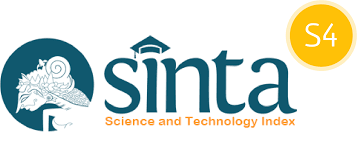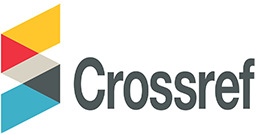Decolorization Of Indigosol Blue Dye Using Trametes versicolor F200 and Aspergillus sp
Abstract
The dyeing process of batik eventually produces much of wastewater. The difficult degradation and the dangers posed within the synthetic dyes are the main concerns in finding efficient wastewater treatment. Biological treatment has been known to be an effective technique of reducing or eliminating color intensity in wastewater. Fungi is one organism that can decompose many environmental pollutants. The aims of this research were to determine the ability of fungal isolates in decolorizing the synthetic dyes and analyzed which treatment has the highest decolorization percentage. Fungal isolates of Trametes versicolor F200 and Aspergillus sp. were used as a biological agent to decolorize of Indigosol Blue dye. The decolorization percentage was analyzed by spectrophotometer method. The result showed that T. versicolor F200 and Aspergillus sp. able to decolorize Indigosol Blue dye. The decolorization treatment of Indigosol Blue dyes using T. versicolor F200 showed the highest decolorization percentage reaching 97.21%.
References
Benito, G.G., Miranda, M.P. & Santos, R.D.L. 1997. Decolorization of Wastewater From an Alcoholic Fermentation Process with Trametes versicolor. Biosource Technology, 61: 33-37.
Claus, H., Faber, G. & Konig, H. 2002. Redox-mediumted decolorization of synthetic dyes by fungal laccases. Appl Microbiol Biotechnol, 59: 672–678.
Dewi, R.S., Rina, S.K., Erni, M. & Yekti, A. 2016. Studi Komparatif Penurunan Warna Limbah Cair Batik Menggunakan Aspergillus Niger. Prosiding Symbion, 269-278.
______, Kasiamdari, R.S., Martani, E. & Purwestri, Y.A. 2018. Decolorization and detoxification of batik dye effluent containing Indigosol Blue-04B using fungi isolated from contaminated dye effluent. Indonesian Journal of Biotechnology, 23(2): 54-60.
Floudas, D., Manfred, B., Robert, R., Kerrie, B., Robert, A.B, Bernard, H., Angel, T.M., Robert, O., Joseph, W.S., Jagjit, S.Y., Andrea, A., Isabelle, B., Alex, B., Alexis, C., Alex, C., Pedro, M.C., Ronald, P.D.V, Patricia, F., Keisha, F., Brian, F., Jill, G., Dylan, G., Pawel, G., Joseph, H., Cedar, H., Chiaki, H.,Kiyohiko, I., Joel, A.J., Nathan, K., Phil, K., Annegret, K., Ursula, K.T.K., Arun, K., Alan, K., Kurt, L.B., Luis F. L., Erika, L., Albee, L., Vincent, L., Susan, L., Taina, L., Rachael, M., David, J.M., Ingo, M., Emanuelle, M., Claude, M., Laszlo, G.N., Matt, N., Robin, A.O., Aleksandrina, P., Antonis, R., Francisco J. Ruiz-Dueñas., Grzegorz, S., Asaf, S., Masahiro, S., Jeremy, S., Jason, C.S., Franz St. John., Jan, S., Hui, S., Sheng, S.,Khajamohiddin, S., Adrian, T., Wiebenga, Darcy, Y., Antonio, P., Daniel, C.E.,26 Francis Martin,15 Dan Cullen,12 Igor V. & Grigoriev, D.S.H. 2012. The Paleozoic origin of enzymatic lignin decomposition reconstructed from 31 fungal genomes. Science, 336: 1715–1719.
Hammel, K.E. 1997. Fungal degradation of lignin. In: Cadisch G, Giller K.E. Eds. Driven By Nature: Plant Litter Quality and Decomposition. London: CAB International, 33-45.
Hemalatha, V., Kalyani, P., Chandana, V.K. & Hemalatha, K.P.J. 2016. Degradation of Textile Dyes by using Aspergillus sp. Int. J. Pure App. Biosci, 4 (6): 176-179.
Mester, T. & Tien, M. 2000. Oxidation mechanism of ligninolytic enzymes involved in the degradation of environmental pollutants. International Biodeterioration & Biodegradation. 46: 51-59
Namboodri, C.G., Perkins, W. & Walsh, W.K. 1994. Decolorizing dyes with chlorine and ozone-part II. Am Dyestufl Rep, 83: 17–26.
Ngo, A.C.R., Devanader, M.K.P. & Dedeles, G.R. 2016. Decolorization of Selected Synthetic Textile Dyes by Yeasts from Leaves and Fruit Peels. Journal of Health & Pollution, 6(10): 42-55.
Park, C., Yuri, L., Tak-Hyun, K., Byunghwan, L., Jinwon, L. & Sangyong, K. 2004. Decolorization of Three Acid Dyes by Enzymes from Fungal Strains. J. Microbiol. Biotechnol, 14(6): 1190–1195.
Setiadi, T., Suwardiyono & Wenten, I.G. 2002. Treatment of Textile Wastewater by a Coupling of Activated Sludge Process with Membrane Separation, Proc. Environmental Technology and Management Seminar. 9-10 Januari. Bandung.
Singh, H. 2006. Mycoremediumtion: fungal bioremediumtion. New Jersey: John Wiley & Sons, Inc.
Slokar, Y.M. & Le Marechal, A.M. 1998. Methods of decoloration of textile wastewaters. Dyes Pigments, 37: 335-356.
Sorta, R.T. 2013. Penyerapan Zn dan Dekolorisasi Beberapa Macam Limbah Cair Batik Menggunakan Limbah Baglog Pleurotus ostreatus Dengan Waktu Inkubasi Berbeda. Skripsi. Purwokerto: Universitas Jenderal Soedirman.
Tadda, M.A., Ahsan, A., Shitu, A., ElSergany, M., Arunkumar, T., Bipin, J., Razzaque, M.A. & Daud, N.N.N. 2016. A review on activated carbon: process, application and prospects. Journal of Advanced Civil Engineering Practice and Research, 2(1): 7-13.
Yang, Seung-Ok., Sodaneath, H., Lee, Jung-In., Choi, Jin-Hee., Ryu, H.W. & Cho, Kyung-Suk. 2017. Decolorization of acid, disperse and reactive dyes by Trametes versicolor CBR43. Journal of Environmental Science and Health. 52(9): 862-872.
Young, L. & Yu, J. 1997. Ligninase-Catalysed Decolorization of Synthetic Dyes. Wat. Res. 31(5), pp. 1187-1193.
Yulisna V. 2000. Dekolorisasi Limbah Cair Berwarna Yang Mengandung Orange oleh Penicillium sp. Bogor: Institut Pertanian Bogor.














_copy.png)



